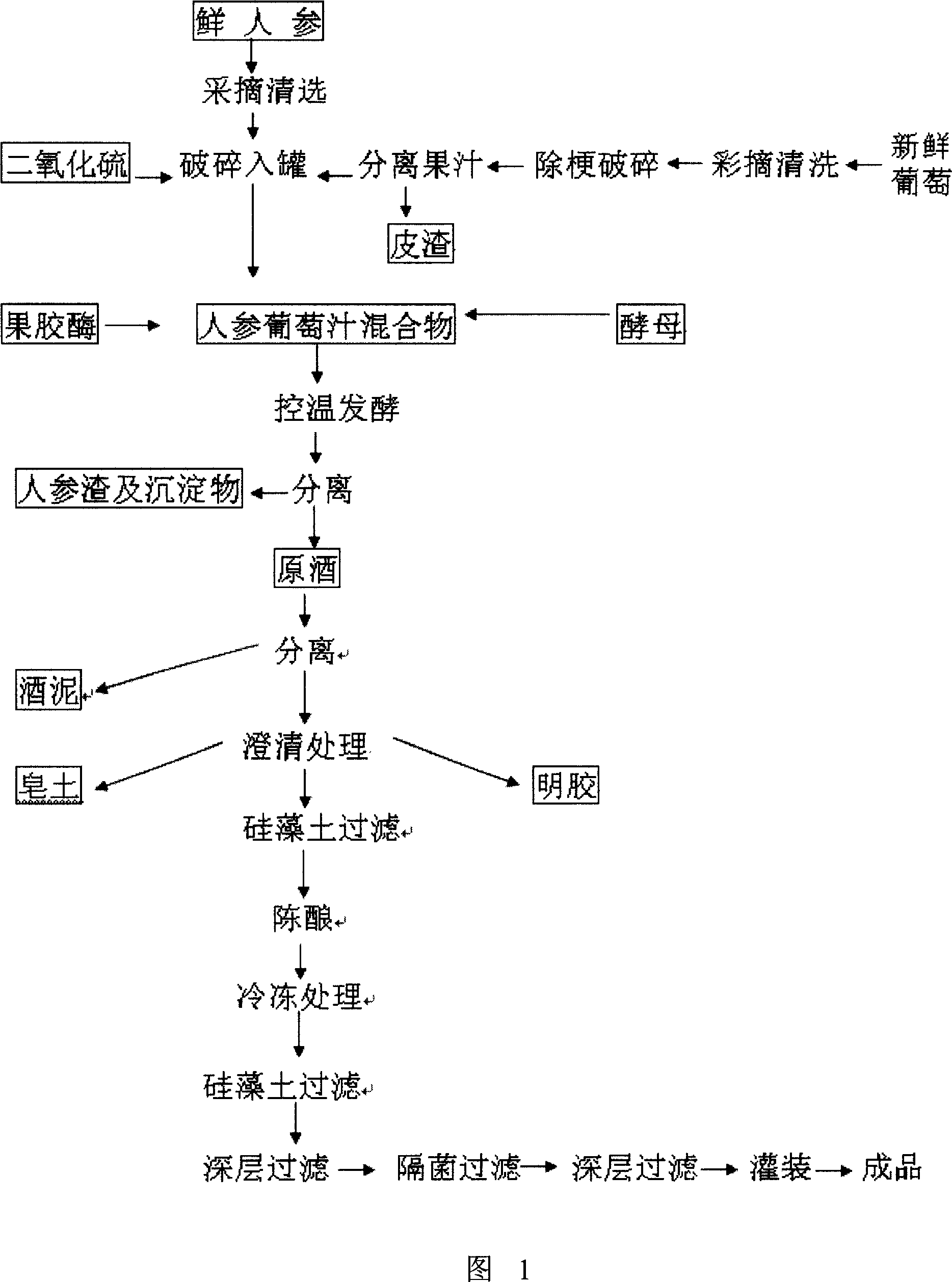Gen-seng grape wine and its preparing method
A wine and ginseng technology, applied in the field of wine products, can solve the problem of less deep processing of ginseng, achieve good health care and medical effects, reduce blood lipids, and have a round and palatable wine.
- Summary
- Abstract
- Description
- Claims
- Application Information
AI Technical Summary
Problems solved by technology
Method used
Image
Examples
Embodiment 1
[0055] Raw material requirements
[0056] Ginseng is selected from mature autumn fruits from Northeast China, and grapes are selected from mature Cabernet Sauvignon, with a sugar content of not less than 195g / l. The ratio (by weight) of fresh ginseng to fresh grapes is: ginseng 5; grape 95.
[0057] The brewing process is as follows:
[0058] 1. Broken:
[0059] A. First crush the ginseng into a slag with a stone mortar.
[0060] B. The crushed grapes are input into the rotary fermenter, and the grape skins and seeds are separated from the grape juice. Thereafter, the grape juice is input into a vertical fermenter with ginseng for mixed fermentation. During this period, sulfur dioxide should be added along with the input of grape pulp. After the grape pulp and ginseng reach the set ratio, the input of grape juice should be stopped, and pectinase and yeast should be added. At this time, it is necessary to measure and record the mixed sugar content and acid content of the t...
Embodiment 2
[0075] Raw material requirements
[0076] For ginseng, choose mature autumn fruits from Northeast China, and for grapes choose mature snake dragon pearl, with a sugar content of not less than 195g / l. The ratio (by weight) of fresh ginseng to fresh grapes is: ginseng 5; grape 95.
[0077] The brewing process is as follows:
[0078] 1. Broken:
[0079] A. First crush the ginseng into a slag with a stone mortar.
[0080] B. The crushed grapes are input into the rotary fermenter, and the grape skins and seeds are separated from the grape juice. Thereafter, the grape juice is input into a vertical fermenter with ginseng for mixed fermentation. During this period, sulfur dioxide should be added along with the input of grape pulp. After the grape pulp and ginseng reach the set ratio, the input of grape juice should be stopped, and pectinase and yeast should be added. At this time, it is necessary to measure and record the mixed sugar content and acid content of the two pulps in ...
Embodiment 3
[0094] Raw material requirements
[0095] For ginseng, choose mature autumn fruits from Northeast China, and for grapes choose mature Cabernet Franc, with a sugar content of not less than 195g / l. The ratio (by weight) of fresh ginseng to fresh grapes is: ginseng 5; grape 95.
[0096] The brewing process is as follows:
[0097] 1. Broken:
[0098] A. First crush the ginseng into a slag with a stone mortar.
[0099] B. The crushed grapes are input into the rotary fermenter, and the grape skins and seeds are separated from the grape juice. Thereafter, the grape juice is input into a vertical fermenter with ginseng for mixed fermentation. During this period, sulfur dioxide should be added along with the input of grape pulp. After the grape pulp and ginseng reach the set ratio, the input of grape juice should be stopped, and pectinase and yeast should be added. At this time, it is necessary to measure and record the mixed sugar content and acid content of the two pulps in the ...
PUM
 Login to View More
Login to View More Abstract
Description
Claims
Application Information
 Login to View More
Login to View More - R&D
- Intellectual Property
- Life Sciences
- Materials
- Tech Scout
- Unparalleled Data Quality
- Higher Quality Content
- 60% Fewer Hallucinations
Browse by: Latest US Patents, China's latest patents, Technical Efficacy Thesaurus, Application Domain, Technology Topic, Popular Technical Reports.
© 2025 PatSnap. All rights reserved.Legal|Privacy policy|Modern Slavery Act Transparency Statement|Sitemap|About US| Contact US: help@patsnap.com

